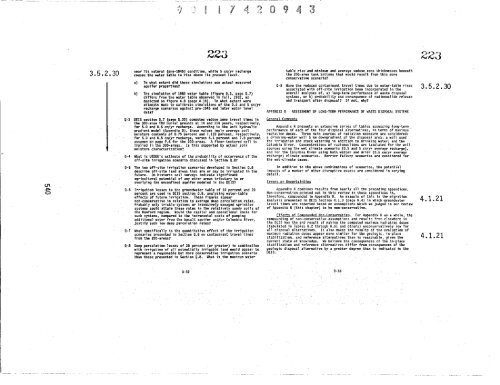EIS-0113_Section_11 - Hanford Site
EIS-0113_Section_11 - Hanford Site
EIS-0113_Section_11 - Hanford Site
Create successful ePaper yourself
Turn your PDF publications into a flip-book with our unique Google optimized e-Paper software.
f " g<br />
r<br />
223 2x2;3<br />
(T1<br />
O<br />
near its natural (pre-1945) condition, while 5 cm/yr recharge<br />
table rise and minimum and average assume zone thicknesses beneath<br />
3 . 5 , 2 a 30V<br />
causes the water tattle to rise above its present level. the 200-area tank bottoms that would result from this more<br />
conservative scenario?<br />
a) To what extent did these simulations use actual measured<br />
aquifer properties?<br />
0-9 Have the reduced contaminant travel times due to water-table rises<br />
associated with off-site irrigation been incorporated in the<br />
b) The simulation of 1983 water table (figure Q.3, page Q.T) overall analyses of, a) long-term performance of waste disposal<br />
differs from the water table observed in fall, 1982, as<br />
systems, or b) probability and consequence of radionuclide release<br />
depicted on figure 4.8 (page 4.18). To what extent were<br />
and transport after disposal? If not, why?<br />
attempts made to calibrate simulations of the 0.5 and 5 cm/yr<br />
recharge scenarios against pre-1945 and later water level<br />
data?<br />
APPENDIX R ASSESSMENT OF LONG-TERN PERFORMANCE OF WASTE DISPOSAL SYSTEMS<br />
.<br />
Q-3 D<strong>EIS</strong> section Q.T (page Q.30) computes badose .zone travel times in General Comments<br />
the 300-area TRU burial grounds at 14 and <strong>11</strong>4 years, respectively,<br />
for 5.0 and 0.5 cm/yr recharge. According to the unit hydraulic<br />
Appendix R presents an extensive series of tables assessing :long-Leon<br />
gradient model (Ap pendix 0)-, these values imply average soil<br />
performance of each of the four disposal alternatives, in terms of maximum<br />
moisture contents of 8.15 percent and 7.125 parcent, respectively, radiation rdozes. Three main. sources of radiation exposu e are considered:<br />
- for 5.0 and 0.5 cm/yr recharge, versus 6.4 percent and 7.8 percent a drinking-water well 5 km doengradient of the disposal area; a well used<br />
assumed on page P.6 for the 200-areas. A finer-textured soil is for irrigation and stock watering in addition to drinking water; and the<br />
implied in the 300-areas. is this supported by actual soil<br />
Columbia River. Concentrations of radionuclides are tabulated for the well<br />
moisture characterization? sources using the wet climate scenario (0.5 and 5 cm/yr average recharge),<br />
-<br />
- and for the Columbia River using both wetter and drier (0.5 cm/yr average<br />
Q-4 What I. USDOE's estimate of the probability of occurrence of the recharge) climate scenarios.. Barrier failure scenarios are considered for<br />
off-site irrigation scenario discussed in <strong>Section</strong> Q.8?<br />
the wet-climate cases.<br />
0-5 The two off-site irrigation scenarios developed in <strong>Section</strong> Q.8 Inaddition to the above combinations of scenarios, the potential<br />
describe off-site land areas that are or may be irrigated in the impacts of A number of other disruptive events areconsidered in varying<br />
future. Do historic soil surveys indicate significant<br />
detail.<br />
agricultural potential of any other areas tributary to or<br />
overlying the unconfined aquifer modeled in the D<strong>EIS</strong>?<br />
Errors or Uncertaint i ei<br />
0-6 Irrigation losses to the groundwater table of 10 percent and 20 A combines results from nearly all the preceding e appendices.<br />
percent are used in D<strong>EIS</strong> section Q.8, analyzing water-table Non- cAppendix Pointed out in this review in appendices is,<br />
effects of future. irrigation. These figures appear<br />
therefore , compounded in Appendix R, An example of this is the migration<br />
non-conservative it relation to average deep parcel ation rates. analysis presented in D<strong>EIS</strong> <strong>Section</strong> R.1.3 (pa g e R.4) in which.. groundwater<br />
Probably only trickle- systems or intensively managed sprinkler travel times are reported based an assumptions. which we judged in our review<br />
systems could attain these rates in the relatively sandy soils of of Appendix 0 (this chapter) to be non-conservative.<br />
the <strong>Hanford</strong> region. Would the capital and operational costs for<br />
- such systems, compared to the incremental costs of pumping<br />
-<br />
Effects of Compounded Non-COrmeraatism. For.. Appendix R as a whole, the<br />
additional water from the basalt aquifer and/or Columbia River, CDMPOundina of n cohhservativa assumptions and results from elsewhere in<br />
Justify such low deep percolation rates?<br />
the D<strong>EIS</strong> has the end result of makino the computed maximum. radiation doses<br />
-. (tabulated in Tables R.2 through R.61 and others) unconservatively low for<br />
04 What specifically is the quantitative effect of the irrigation all disposal alternatives. It also makes the results of the evaluation of<br />
scenarios presented in <strong>Section</strong> Q.8 on contaminant travel times maximum radiation doses appear more similar for the geolcgi-, in-place<br />
from the 200-areas?<br />
stabilization, and reference alternatives than is reasonable, given the<br />
current state of knowledge.We believe toe consequences of the in-place<br />
Q-8 Deep percolation losses of 20 percent (or greater) in combination stabilization and reference alternatives differ from consequences of the<br />
with irrigation of all potentially irrigable land would appear to geologic disposal alternative by a greater degree than is indicated in the<br />
represent a reasonable but more conservative irrigation scenario D<strong>EIS</strong>.<br />
than those presented in <strong>Section</strong> Q.B. What is the maximum water<br />
3.5.2.30<br />
4.1.21<br />
4.1.21<br />
3-32 3-33

















